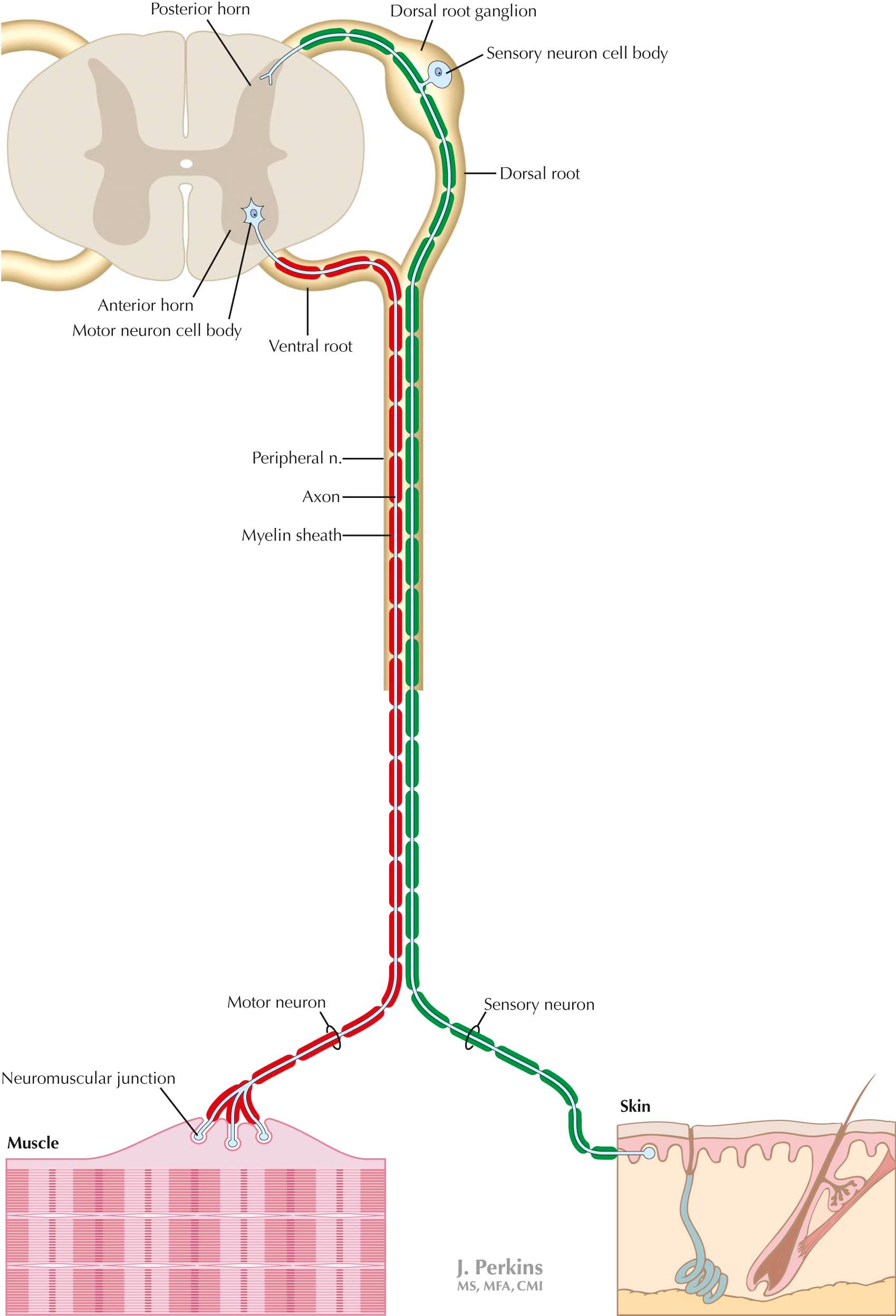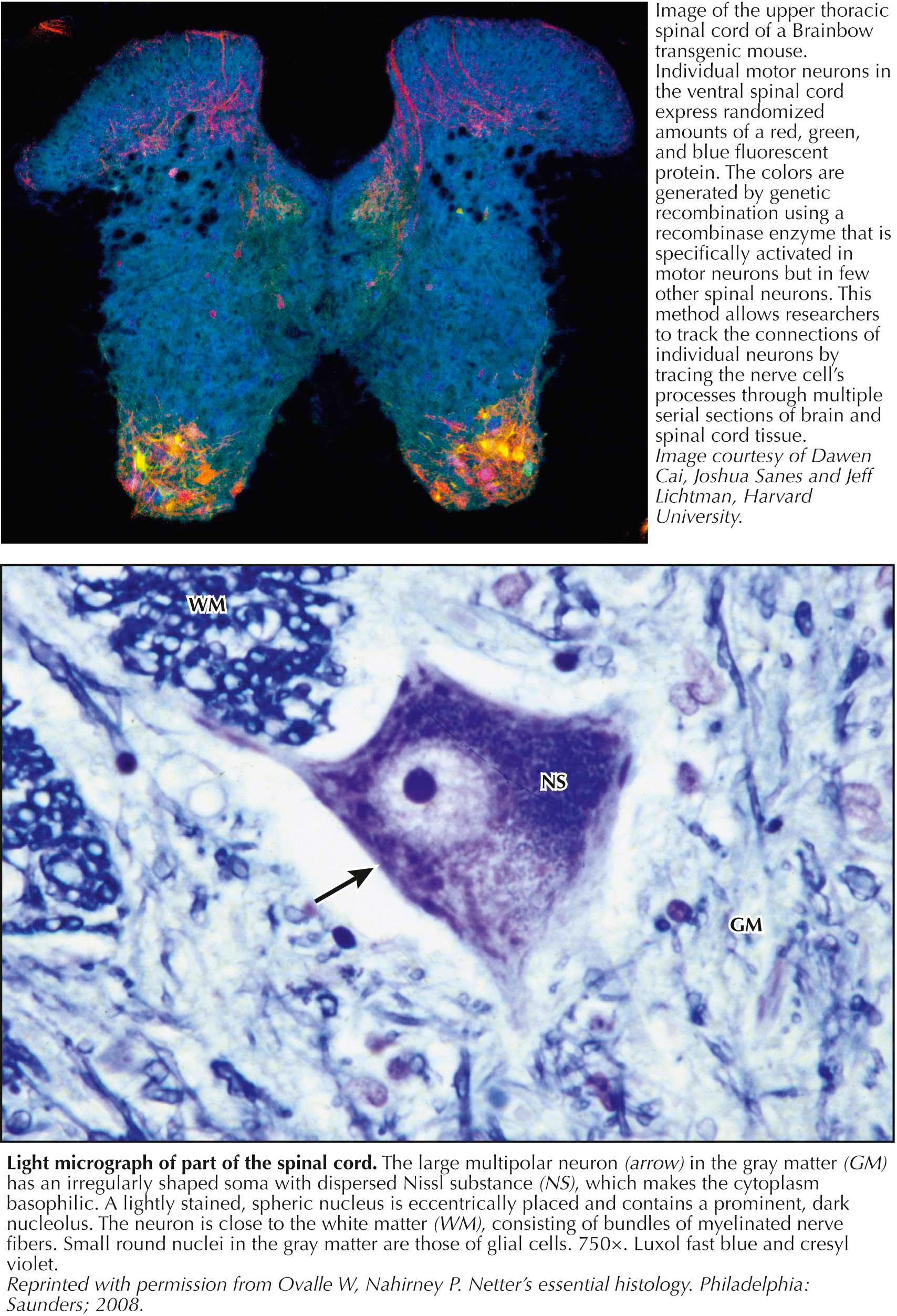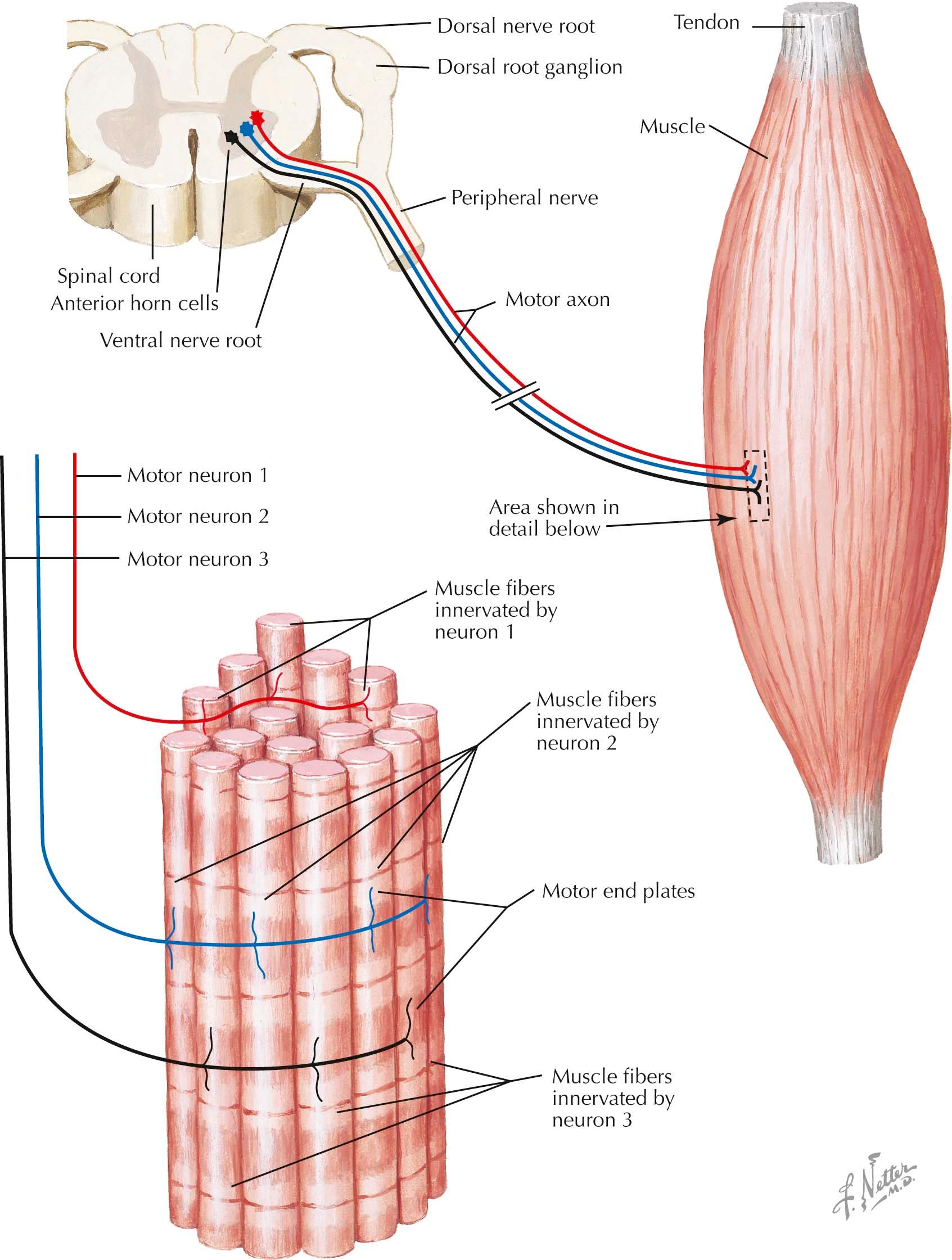Physical Address
304 North Cardinal St.
Dorchester Center, MA 02124

The major function of the nervous system is the transmission and processing of information. This relies on propagation of electrical signals between the peripheral nervous system and the central nervous system. The somatic peripheral nervous system is composed of afferent (sensory) neurons (green in the figure) and efferent (motor) neurons (red in the figure). The first-order somatic sensory neurons transmit the initial electrical signals generated by a sensory stimulus. For example, a sensory stimulus to the skin initiates sensory processing by activating the local sensory receptors within the skin. A sensory nerve action potential (electrical signal) is generated and propagates along the afferent sensory axons within a peripheral nerve, toward the spinal cord. The final-order somatic motor neurons generate a signal within the anterior horn cells in the spinal cord, after depolarization of the anterior horn cells from a central activation. The action potentials propagate away from the spinal cord through the motor axon, generating a cascade of reactions at the neuromuscular junction and muscle, ultimately leading to muscle contraction. The somatic sensory and motor neurons have several morphologic differences.
The peripheral somatic sensory neurons are bipolar neurons. The sensory neuron cell bodies reside in the dorsal root ganglion, that is, situated posterolateral to the spinal cord, usually at or near the intervertebral foramen. Extending out from the cell body are two axon extensions; one extending distally to the skin or other organs and one extending proximally through the dorsal root into the posterior horn of the spinal cord. The relationship between the sensory neuron cell bodies within the dorsal root ganglion and the sensory axons is important; when the axon branch (either the distal or proximal branch) is separated from the cell body, the separated axonal component undergoes axonal (wallerian) degeneration. As a result, an injury at the proximal nerve root (“pre-” or proximal to the ganglion) will lead to sensory deficits even though the distal sensory axon remains intact. The clinical implications of this occur during electrophysiologic testing with nerve conduction studies in which a distal sensory nerve is studied. In the presence of sensory loss in an extremity, a preserved or normal sensory nerve conduction study response suggests that the sensory loss is caused by a disorder involving the sensory pathway, either in the proximal root (proximal to the ganglion) or the central somatosensory conduction pathways in the spinal cord or brain and not the peripheral nerves per se.
Several structurally different types of sensory neurons exist within a somatic nerve. The largest sensory neurons are type IAα and Ib fibers, which are large, myelinated fibers whose function is to transmit proprioceptive signals from muscle spindle endings, Golgi tendon organs, and proprioceptive sensory receptors. Type II (Aβ) fibers are smaller myelinated fibers that transmit signals from the muscle spindles and skin receptors controlling touch and pressure. Type III (Aδ) fibers are small myelinated fibers that play a role in sharp pain, temperature, touch and pressure, and visceral sensations. In addition, small unmyelinated fibers, type IV (C), contribute to sensation of somatic and visceral pain.
Somatic motor neurons are unipolar neurons. The motor neuron cell bodies reside in the anterior gray matter (anterior horns) of the spinal cord. A single axon extends distally from each anterior horn cell, through the ventral root, and joins the peripheral nerve that innervates individual muscles. The motor conduction pathway continues along the nerve to the nerve terminal. At this site, an action potential traveling through the motor axon to the nerve terminal leads to a cascade of reactions at the neuromuscular junction, where the nerve terminal is adjacent to the muscle fiber. Through these reactions, an action potential is generated along the muscle fibers, resulting in muscle fiber contraction. The integrity of the motor unit (an anterior horn cell and its axon, nerve terminal, neuromuscular junction, and innervated muscle fibers) can be tested during electrophysiologic testing with motor nerve conduction studies.
Motor neurons are typically large in diameter and myelinated. The major type of motor neuron, the alpha motor neuron, innervates the extrafusal striated muscle fibers and, primarily, is responsible for muscle fiber contraction. Smaller, myelinated gamma motor neurons innervate the intrafusal fibers of muscle spindles.

The cell body (soma) is the major structural component that maintains the neuron. The motor neuron cell body resides in the ventral horn of the spinal cord as an “anterior horn cell” or in the cranial nerve nuclei within the brainstem. The cell body is the metabolic center of the neuron and performs numerous functions necessary to maintain the health and function of the neuron. Within the cell body are numerous organelles, each of which serves a particular role for the neuron. The nucleus and nucleolus contain the cell's deoxyribonucleic acid (DNA). The mitochondria play the important role of energy metabolism within the neuron and produce adenosine triphosphate (ATP), which is necessary for other metabolic processes within the cell to occur. The rough endoplasmic reticulum, along with the Nissl substance and its associated ribosomes, synthesize proteins that are then secreted through the smooth endoplasmic reticulum and Golgi apparatus. In these latter organelles, the proteins undergo certain modifications. The proteins are subsequently packaged into vesicles that store and transport proteins throughout the cell. Lysosomes are organelles that are responsible for degradation of molecules within the cell.
Each neuronal cell body contains many dendrites, which are peripheral extensions from the cell body that, along with the smaller dendritic spines (gemmules), receive the input from other neurons. Each dendrite receives excitatory or inhibitory potentials from the nerve terminals of neighboring neurons at the axodendritic synapses . The dendrites and the cell body of a single neuron may have hundreds of synapses from many different neurons. Each of the postsynaptic excitatory or inhibitory potentials are summated to determine whether an action potential will or will not be initiated within the neuron. When initiated, an action potential originates at the axon hillock, the region of the cell body at which the axon originates. Distal to the axon hillock is the axon, which is the structure that conducts the electrical activity and trophic factors away from the cell body toward other neurons or organs. The course of the axons and route of conduction of the electrical signals varies according to the type of neuron and its function.
The somas of the somatic sensory neurons are located in the dorsal root ganglion, just lateral to the spinal cord and typically within the intervertebral foramen. The somatic sensory neurons are bipolar neurons with two axonal extensions, one conducting impulses from the sensory receptors, including free nerve endings and pacinian corpuscles, toward the dorsal root ganglion through the peripheral nerves and dorsal rami, and the other extending from the dorsal root ganglion through the dorsal root into the dorsal column of the spinal cord.
The cell bodies (anterior horn cells) of the somatic motor neurons are located in the anterior gray matter of the spinal cord. The motor neurons are unipolar neurons, and each neuron has an axon that extends through the ventral root and then through either the dorsal ramus (innervating paraspinal skeletal muscles) or the ventral ramus (innervating limb and peripheral skeletal muscles) and into individual nerves.
The cell bodies of the sympathetic autonomic peripheral neurons are located in spinal cord. The preganglionic sympathetic neurons extend through the ventral root and through the white ramus communicans, and they synapse in peripherally located ganglia—either the sympathetic chain adjacent to the spinal cord or the collateral sympathetic ganglia near the organs that the neurons supply. After synapsing at either site, the postganglionic sympathetic neurons course to the end organs, including vascular smooth muscle, sweat glands, and arrector pili muscles in the skin or the smooth muscles and glands of other organs.

The outflow of nearly all behavior depends upon the neuromuscular system where nerves emanating from the spinal cord and brainstem connect with skeletal muscles, allowing us to move, stand, and express ourselves. The numbers of skeletal muscles in the human body is daunting, between 500 and 1000. Our face has enormous numbers of muscles, allowing us to express emotions, communicate, and eat our food. Our hands are the second most “muscular” parts of our anatomy. These provide humans with the finesse to write and speak, for a surgeon to perform the most intricate finger movements, to form sign language, to play musical instruments, and occasional individuals to sing in the most beautiful fashion. The “motor unit” is the “final efferent pathway” of the peripheral somatic motor pathway. A motor unit is defined as a single anterior horn cell or brainstem motor neuron, its axon, and all of the muscle fibers innervated by that axon.
Some muscles are huge. The gluteus maximus has many thousands of muscle fibers essential to walking. Miniscule muscles are designed to produce the slightest movements of the eardrum or the larynx; these often have fewer than 100 muscle fibers. The set of muscle fibers innervated by a single axon, a motor unit , is very small for muscles that require very fine control, such as the extraocular and finger muscles. All of the muscle fibers within a single motor unit are of the same fiber type. Some motor units are even smaller than 10, that is, 1 motor axon innervating only 10 muscle fibers (e.g., in the extraocular muscles). In contrast, other motor units, not requiring fine control, are very large, hundreds to thousands, these innervate very massive postural (back musculature) as well as girdle and extremity muscles (gluteus maximus and gastrocnemius muscles). Because an action potential impulse heading out an axon in a peripheral nerve will enter all the branches of the axon, the motor unit is the unitary muscle contraction from a single axon . When muscles are activated, motor units are recruited in a fixed order . Typically, the weakest motor units causing the smallest muscle twitches are recruited first . If insufficient numbers are recruited for the task, additional motor units are activated, each progressively producing larger amounts of muscle tension. In this way, there is fine control of small muscle contractions and less control as muscle contraction force is increased. All muscle fibers within a single motor unit have similar contraction properties because they have similar subtypes of the contraction protein myosin.
Within a small section of muscle, the fibers of several (up to 10 or more) different motor units are interspersed with each other. (bottom part of Plate 10-3 ). This figure illustrates the anatomy of three different “ motor units ” forming the final peripheral components of the descending motor pathway that emanates from a single anterior horn motor neuron cell body and all axons and muscle fibers innervated by that single neuron. The cell bodies of the motor units lay within the brainstem for motor cranial nuclei, serving the somatic cranial muscles, such as the extraocular, facial, and pharyngeal muscles, and within the anterior horn cells of the spinal cord for the motor neurons serving somatic motor function to the noncranial muscles.
The upper left illustration demonstrates that cells bodies of each of three motor units originate within spinal cord anterior horn gray matter. The peripheral axon arising from each anterior horn cell leaves the spinal cord through the ventral nerve root to course as a peripheral nerve component until reaching the muscle. Here the nerve terminals of different motor units are positioned in a relatively confined intramuscular area named the “end-plate zone” or “ motor point. ” At this site, there are high concentrations of acetylcholine receptors attached within the muscle fibers. It is here, usually toward the middle of a muscle, that muscle fiber action potentials are generated after acetylcholine is released and bound to the receptors.
The first motor units recruited comprise muscle fibers having “ slow” fatigue-resistant myosin that cause slow contractions. The last motor units to be recruited activate muscle fibers that have fast contractions thanks to fast myosin but are highly fatigable . It is possible to see positions of all muscle fibers within each of the motor units in one muscle. Such descriptions reveal “connectomes” that are complete maps of all the positions of all the motor axons and their connections within a muscle.
Become a Clinical Tree membership for Full access and enjoy Unlimited articles
If you are a member. Log in here